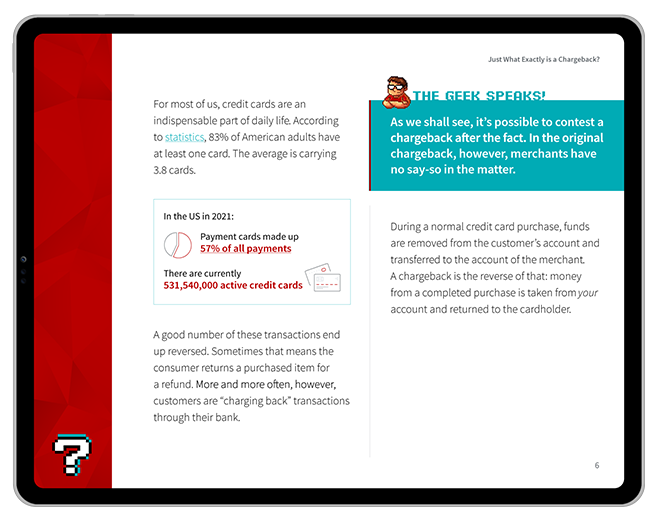What is a Payment Processor? Here's Processing Explained, Plus the Top 10 Service Providers of the Year
Credit cards were used to conduct 625 billion transactions in 2022. For merchants, that’s a glaring incentive to accept credit and debit cards.
You can’t accept card payments all on your own, though. You need a payment processor to take credit card payments.
So, what does a payment processor do? And, how do they help you and your bank manage transactions? Let’s take a look.
Recommended reading
- 7 Common Reasons Why Issuer Declines Happen
- Merchant Identification Number: How to Find Your Merchant ID
- My Bank Account is Under Investigation? What’s Going On?!
- VAR Sheets: Get All Your Documents Ready in 4 Basic Steps
- Internet Processing: Understanding the eCommerce Process
- Issuer vs Acquirer: What’s the Difference?
What is a Payment Processor?
- Payment Processor
A payment processor is a company that facilitates credit card payments on behalf of a merchant by receiving, communicating, and relaying the cardholder’s information between issuing and acquiring banks.
[noun]/pā • mənt • prä • se • sər/A payment processor manages transactions between the payer and the payee’s bank in a financial transaction. This system primarily facilitates the transfer of funds from customers’ accounts to merchants’ accounts when purchases are made using debit cards, credit cards, or other electronic payment methods.
Payment processors ensure secure and efficient transaction processing. This is done by verifying the details involved in a payment, such as a cardholder’s information and the availability of funds. They facilitate and communicate transaction details between the bank, the merchant, and the customer. Thus, they act as an essential bridge in the financial ecosystem.
Payment Processors, Gateways, & Acquirers: What's the Difference?
Three parties — processors, gateways, and acquirers — are integral to the transaction process. While they often work closely together, each has a distinct role. Let's hammer out each party’s role before we get too deep into the weeds.
The processor works on your behalf as a merchant. It confirms the validity of a transaction, checks the availability of funds, and enables the transfer from the customer's account to the merchant's account. In contrast:
Payment Gateway
A gateway is the digital equivalent of a point-of-sale terminal. The gateway encrypts sensitive information like credit card numbers to ensure that information passes securely between you, your customer, the payment processor, and the acquiring bank.
Learn more about gatewaysAcquiring Bank
An acquiring bank is a financial institution that maintains your merchant bank account. This bank receives the payment from the customer's bank. Once the transaction is authorized, the acquiring bank deposits the transaction amount into your account.
Learn more about acquirersHow Payment Processing Works
Processors work as a “middle man” to conduct payments. The transaction can be processed quickly as long as the customer has the necessary funds available for the transaction and has been verified by their issuing bank.
Here’s how payment processing works:
Step #1
The customer presents their card information via an online form or physical POS terminal to pay for goods or services.
Step #2
The information is submitted through a payment gateway once those details are entered.
Step #3
The customer’s payment credentials and transaction information are sent to the processor via the payment gateway. The processor then sends that information to the card network, who forwards it to the cardholder’s bank.
Step #4
The issuer verifies the cardholder’s account and balance, then provides an authorization response to the card network.
Step #5
The card network will notify the payment processor whether the payment request is approved or denied. This response is then transmitted to you via the payment gateway.
Step #6
The transaction is now complete. After you submit transactions for settlement (called “batching”), the payment processor requests that the corresponding issuer send the funds from the transaction to the acquirer.
Step #7
You receive the funds from the sale. Depending on the processor and type of account, the transfer could occur instantly, or within a few business days.
What is a Payment Processor Fee?
First, you want to choose the company that best suits your budget. Pricing structures for payment processors tend to vary according to your industry, sales volume, and merchant status (standard versus high-risk processing). The three most common pricing models are:
#1 | Interchange-Plus Pricing
This pricing method includes the interchange rate (the fee charged by the card network), plus a markup, which can be a fixed amount, percentage-based, or both.
Pro:
This method can be less costly than the others, especially for businesses that process a large number of transactions.
Con:
Interchange rates can vary from transaction to transaction, making it difficult to predict costs from month to month.
#2 | Flat-Rate Pricing
This pricing method ensures a single rate for all transactions through a given method, regardless of interchange rates and fees. This would mean you’d pay a set percentage on top of your transaction rate; for example, 3% of the total plus $0.25 for every transaction.
Pro:
Flat rates aren’t subject to fluctuation. You know what you’re getting into, relative to the dollar value of your sales and the number of transactions processed.
Con:
It could be more expensive than the other tiers if a company processes many transactions annually.
#3 | Tiered Pricing
This pricing method combines both interchange-plus and flat-rate pricing by sorting rates into grouped categories. Let’s say that you might pay 2% plus $0.15 for debit transactions, but 3% plus $0.10 for credit card transactions. These rates and fees are variable, following a predetermined ruleset.
Pro:
Tiered pricing offers predictability combined with competitive pricing.
Con:
If you are a high-risk merchant or process a large number of payments overall, the costs associated with a tiered pricing scale could be very high.
Additional factors to consider when determining which model is best for your needs include:
- Quotes: Most payment processors list their pricing details on their websites. Some will require that you contact them for an individualized quote, though.
- Vertical: Some processors offer multiple payment methods according to your product category, vertical, etc.
- CNP Premiums: Online transactions carry higher fees due to the increased fraud risk compared to brick-and-mortar sellers.
- Equipment: The actual POS terminal can get expensive. Some processors allow you to take payments from a tablet or other common device.
Questions to Ask Before Choosing a Payment Processor
With few exceptions, there’s simply no way you can operate a profitable business without taking credit card payments. Which service provider should you choose, and how can you tell which is best suited for your needs, though?
Beyond the pricing model, here are a few other things to consider before you choose a payment processor:
Direct vs. Third-Party Merchant Accounts
So, those are a few of the preliminary questions to consider. Another important question to ask is: How will you get paid?
There are two basic types of payment processing accounts to choose from here: direct and third-party providers.
Direct Merchant Account
A direct merchant account is an account opened for you, by your acquiring bank, with assistance from a payment processing provider. However, you own the account directly.With a direct account, the money will be taken from the cardholder’s issuing bank and given to your acquiring bank within a given timeframe. Some merchant accounts allow advance access, though some may take a few days to finalize. When you think of a direct merchant account, you’re thinking of those offered through traditional banks or massive payment processing companies like Payment Depot.
Third-Party Merchant Account
With a third-party account, a provider opens a sub-account for you, then conducts credit and debit card payments on your behalf. You don’t own the account; your payment processor does.Some payment processors like Stripe and Square maintain their own merchant accounts, which you pay them to access. When you take a payment, the funds are rerouted to a subsidiary account that you must open and manage from within that processor’s client portal.
Though you don’t have direct access to your own merchant account with the bank and network, choosing a third-party provider can grant you access to funds faster since you are technically being paid by the processor rather than the bank.
The Top 10 Payment Processors for 2024
We took a detailed look at today's highest-rated payment processing companies and developed a comprehensive rundown of the leading service providers.Ratings and reviews were averaged based on sources featured by Forbes, Nerdwallet, and TechRadar. The pros and cons listed are paraphrased directly from real, firsthand customer reviews on G2.com.
#1 | PayJunction
“Best Payment Processor for Balanced Service”
PayJunction offers easy-to-use solutions for small to medium-sized businesses, facilitating the acceptance of credit and debit card payments in-store, online, and remotely. They offer secure, forward-thinking services, such as a touch-free payment method for face-to-face transactions, and environmentally friendly remote payment features including digital billing, signatures and receipts.
PayJunction's payment solution uses cloud technology to securely integrate with top-tier business software and management systems through RESTful APIs. This makes it ideal for businesses seeking a unified payment solution. PayJunction is a great choice for those on the lookout for a standalone, ready-to-use solution.
.
Pros:
- Outstanding, personable customer support
- Clean and concise reporting
- Accurate and easy-to-use online portal and POS terminals
Cons:
- In some cases, processing fees are deducted daily instead of monthly
- For a multi-location business, transaction limits cannot be extended or applied to sister locations
- Limited mobile processing options
Pricing: Two-tier, volume-based pricing
Transaction Fees: Interchange + 0.75% per transaction. Additional fee of $0.07 for swiped credit card transaction, which may vary depending on card/transaction type.
Extra Perks:
- Month-to-month service
- Securely store and recharge cards on file
- Streamlined electronic invoice payments
- Automated sales reports
- Hosted checkout
#2 | Payline
“Best Payment Processor for Brick-and-Mortar”
Payline, a subsidiary of Pineapple Payments, delivers business solutions to a diverse range of organizations. From budding startups to large Fortune 500 corporations, they can play a crucial role in optimizing the payment experience.
Payline specializes in gateway payment processing, and their web solutions are compatible with over 175 different online shopping carts. In addition, the company has developed mobile solutions that permit payment processing through mobile applications. Payline's payment gateway even works in tandem with QuickBooks, simplifying payroll management and overall business financial tasks.
Physical stores are charged a monthly fee as well as a nominal percentage per transaction. However, for online stores, both the monthly and per-transaction fees are slightly higher.
Pros:
- Easy to use and set up
- No early termination fees
- Excellent customer service and clarity are guaranteed
Cons:
- Occasional program glitches noted by customers
- Transaction costs are not fully transparent
- Not available outside the US
Pricing: Call for a free quote
Transaction Fees: In-person transactions are 0.2% + $0.20 per transaction, and a fee of $20 per month. CNP transactions are 0.4% + $0.20 per transaction, plus the $20 monthly fee.
Extra Perks:
- Built-in security and fraud protection
- Mobile app integration
- Lower monthly fee
#3 | Stripe
“Best Payment Processor for Payments Technology”
As reported by Forbes, Stripe stands tall among its competition when it comes to digital transactions. In addition to accepting all kinds of mobile wallets, it also accommodates Apple Pay and Google Pay as well as well-liked international platforms like Alipay and WeChat Pay. Stripe provides the service of accepting payments or repeated charges through ACH debit, ACH credit, or wire transfers for a marginal fee of 0.8% (limited to $5).
Stripe is tailored for more substantial enterprises and provides a multitude of APIs that empowers vendors to create their own bespoke subscription services, on-demand marketplaces, or crowdfunding podiums. It is compatible with a variety of programming languages, such as Ruby, Python, PHP, and Java.
Stripe also furnishes credit card readers that can be integrated with well-known eCommerce and accounting tools, including Shopify, WooCommerce, and Xero. Generally, payouts are accessible within a two-day timeframe, but there's also an option for instant payouts for an added 1% ($0.50 minimum). To top it all, Stripe extends round-the-clock email, chat, and phone support.
Pros:
- Faster, frictionless payments
- Seamless to set up and use, and comes with a variety of integration options
- One of the best tools for collecting payments from different countries/currencies
Cons:
- Requires fundamental tech savvy to operate (large learning curve)
- Stripe has slightly higher fees than Square, and takes a day longer to deposit funds
- Spotty customer service where troubleshooting is involved
Pricing: Flat rate pricing, with $0 monthly fees
Transaction Fees: 2.7% + $0.05 per transaction for card-present payments. 2.9% + $0.30 per transaction for online or manually keyed-in payments.
Extra Perks:
- Global processing
- Omnichannel
- Instant payouts available
- Transparent pricing structure
#4 | Square
“Best Payment Processor for Small Businesses & Startups”
Square is a versatile payment solution designed to bolster the capabilities of small enterprises and startups in accepting both online and physical credit card transactions. Over the years, the company has expanded its offerings with a variety of channels, integrations, and platforms to cater to all kinds of businesses.
Square features a comprehensive collection of tools for both eCommerce and physical stores. They boast a user-friendly dashboard that consolidates every stream of income and data source, providing sophisticated analytics. Its hardware and software options operate seamlessly, offering modern, hassle-free business solutions.
Apart from that, Square also provides cash register and payment hardware to retailers, eateries, and more. They make is simple to offer loyalty programs and appointment setting, and to manage inventory.
Pros:
- Accepts multiple forms of payment that arrive in your bank account within one business day
- Pays out next business day
- Easy to setup and use
Cons:
- Pricing model makes it less cost-effective for bigger companies
- Deposit limits and add-on services are pricey
- Hardware can sometimes be buggy
Pricing: Flat rate pricing, with $0 monthly fees
Transaction Fees: Card-present payments are 2.6% + $0.10 per transaction. Card-not-present payments are 2.9% + $0.30 per transaction. Keyed-in payments are 3.5% + $0.15 per transaction.
Extra Perks:
- Next-business day transfers
- Account takeover protection
- End-to-end encrypted payments
- Active fraud prevention
- Dispute management
- Data-security (PCI) compliance coverage
#5 | ACI Worldwide
“Best Payment Processor for Online Payments”
ACI Worldwide provides white-label payment gateways for payment service providers (PSPs), independent sales organizations (ISOs), acquirers, independent software vendors (ISVs), and value-added resellers (VARs). This service enables businesses to completely delegate their payment transaction processing needs and incorporate a gateway-to-gateway solution.
ACI Worldwide's offering is an intelligent, flexible payment platform designed for global expansion. Their services help facilitate customer journeys, accept all forms of payments, mitigate fraud, and fine-tune payment setup. With ACI Worldwide, merchants can achieve optimal conversion at the lowest possible expense.
Pros:
- Best encrypted payment portal, with real-time alerts
- Superior analytics and conversion data
- Designed specifically with eCommerce in mind
Cons:
- Pricing and fees lack transparency
- Limited personalization with integration
- Payments are not frictionless; advanced security measures increase false negatives
Pricing: Call for a free quote
Transaction Fees: No data; call for clarification
Extra Perks:
- Omnichannel solutions
- Wide range of products to choose from
#6 | Authorize.Net
“Best Payment Processor for Flexible Payments”
As per G2, Authorize.Net (a Visa entity) accepts all prominent credit cards such as Visa, Mastercard, American Express, Discover, Diner’s Club, and JCB. Moreover, it is also compatible with digital payment modes like Apple Pay, PayPal, and Visa Checkout.
The software can process transactions from customers globally, but it necessitates that the businesses looking to use this service must be registered in regions like the US, UK, Canada, Europe, or Australia.
Plans start with a gateway-only package, which does not entail a setup fee, only a recurring monthly gateway fee, along with a per-transaction fee and a daily batch fee. On the other hand, the platform also offers enterprise solutions, which provide customized, all-encompassing pricing tailored for larger business necessities.
Pros:
- Simple, easy-to-navigate interface
- Robust security protocols that help against fraud and chargebacks
- Merchant payouts are processed and finalized in just a few days
Cons:
- False positives and negatives are common
- The Authnet Dashboard has not changed in over a decade, and could use a modern facelift
- The platform is pricey
Pricing: $25 monthly gateway fee. Setup is $49.
Transaction Fees: All-in-one option with a per-transaction rate of 2.9% + $0.30, with no setup fee.
Extra Perks:
- Global merchant account provider
- Support for credit cards and digital providers
- Wide range of currencies supported
- Designed for any business
#7 | Payment Depot
“Best Payment Processor for High-Volume Sales”
In contrast to most payment processing firms that deduct a share from each business transaction, Payment Depot implements a subscription-style pricing structure. Pricing is based on a merchant's monthly transactional volume. In other words, merchants are charged a uniform fee for every transaction, on top of the interchange rate, irrespective of the transaction category.
Payment Depot doesn't impose any hidden fees or cancellation charges. Simultaneously, it enables access to funds in 48 hours or less following a transaction. They also present an assortment of terminals, credit card readers, and point-of-sale (POS) systems, bolstered by round-the-clock customer service.
Payment Depot is optimally suited for merchants dealing with high-volume transactions or those frequently processing high-value products and services.
Pros:
- Saves merchants a ton of money in fees
- Customer care and support are top-notch
- Month-to-month billing
Cons:
- Hardware options are limited
- Pricey for businesses with lower volumes
- High-risk businesses may be denied
Pricing: A flat $79 to $99 per month (Enterprise membership starts at $199) with a monthly transaction limit of $25,000 to over $300,000 depending on the plan.
Transaction Fees: Fixed $0.07 to $0.15 per transaction, plus the interchange rate.
Extra Perks:
- Low transaction fees
- 24/7 customer support
#8 | Veem
“Best Payment Processor for International Payments”
Veem is a transaction administration solution that simplifies the complete AP/AR cycle. It integrates flawlessly with top accounting software, offers live tracking for payments, and presents versatile, cost-effective payment alternatives. This empowers businesses to collect payments in a way that suits them, while decreasing hurdles with customers for fast settlement.
Veem provides widespread access to internet-based global payment tools. It lets merchants send and receive money in 100 nations and more than 70 currencies, all through a single payment network. This service allows businesses to monitor international payments from initiation to completion with the convenience of real-time updates on transactions.
Pros:
- Transactions are easy and traceable
- All-in-one dashboard
- Low cost for international payments
Cons:
- Transactions can take 4-6 business days to process
- Not all countries are represented
- Setup and onboarding is dodgy
Pricing: Two-tier pricing scale—international and domestic (international wire transfers start at $29 per transaction)
Transaction Fees: Transaction Fees: 2.9% per transaction; 1% of total amount.
Extra Perks:
- Mass pay options for contractors and partners
#9 | BlueSnap
“Best Payment Processor for Vendor Partnerships & Split Payments”
BlueSnap enables transactions across desktop and mobile sales, plus marketplaces, subscription services, invoice payments, and manual orders via a virtual terminal. The firm also provides seamless integrated solutions for businesses in search of embedded payments. This is done through white-labeled payments for platforms with automatic underwriting and onboarding, thereby accommodating marketplaces and split payments.
With a single integration and contract, businesses have the chance to expand their horizons to over 200 locations worldwide. BlueSnap makes it easy to accept payments in 47 nations, 110+ currencies, and using 100+ global payment methods. It includes renowned eWallets and automated accounts receivable. These facilities are fortified by top-tier fraud prevention and chargeback management, in-built solutions for regulatory and tax conformity, and consolidated global reporting designed to assist businesses in their growth journey.
Pros:
- New features continuously available
- Bluesnap is very accommodating for unique needs and works with merchants to modify workflows to fit the business requirements
- Integration with hosted fields is fairly simple and seamless
Cons:
- Technical support needs work
- Good reference docs, but no helpful implementation guides, recommendations for choice among the various technical solutions, etc
- Patchwork system; not all facets of operations are on the same platform
Pricing: Pay-as-you-go pricing, with $0 startup, monthly, or cancellation fees
Transaction Fees: 2.9% + $0.30 per successful card transaction
Extra Perks:
- Global processing with one account
- Interchange plus, tiered or flat-rate pricing
- Level 2 and Level 3 data processing rates
- Charity or nonprofit payment processing rates
- Accounts receivable automation
#10 | GoCardless
“Best Payment Processor for Recurring Billing”
Known as the leading authority in recurring transactions globally, GoCardless also boasts the title of being the biggest platform for direct, bank-to-bank debit transactions. Their services, which span over 30 of the world's most robust economies, have simplified the payment process for more than 55,000 enterprises across the globe. They cater to businesses of all sizes, including noteworthy brands such as DocuSign, TripAdvisor, and The Guardian.
As mentioned, GoCardless specializes in gathering payments through direct debit, smoothly integrating with clients' pre-existing billing software or payment gateway. They boast compatibility with over 200 partners, including noted entities like Zuora, Salesforce Billing, Recurly, and Yaypay.
Pros:
- Online dashboard interface is clean and user-friendly
- Minimal fees
- Excellent processes for automated payments
Cons:
- Any per-transaction price increases are substantial
- Can be difficult to speak to a real person when tech support is required
- Slight delay in payouts
Pricing: Two tier per-transaction pricing; custom pricing available.
Transaction Fees: 1% + $0.25 for domestic transactions, with a maximum of $2.50 per transaction.An additional fee of 0.3% applies to transaction values above $1,000. Failure and chargeback fees apply. For international transactions, the fee increases to 2% + $0.25 per transaction; currency conversion is included, with exchange rate powered by Wise.
Extra Perks:
- Personalized billing
- Accounting integration
- Usage tracking
Are There Alternatives to Payment Processing?
What if you don’t use a payment processor? How can you process payments?
It’s technically possible to run a business without a payment processor. However, you’d limit your business to three payment options: cash, check, or money order. That’s simply not practical; after all, who even carries a checkbook with them anymore? Who’s going to take out a money order to pay for something in person?
Credit cards are the currency of our new digitized age. To turn a stable profit, you must be where your customers are, and accept the payment methods they want to use.
While there are some alternatives to conventional processing, like Paypal or Venmo, you will need some platform that can allow you to accept card payments. Choosing your processor based on the factors listed above will dramatically improve your chances of achieving a symbiotic relationship with processors and banks.
Chargeback Management Can Help
If you’re on the fence about payment processors because you are experiencing a high number of chargebacks, effective chargeback management could be your solution.
Chargebacks911® enables sellers in all MCCs, sales models, and product verticals to increase profitability. We help standard merchants avoid excess chargebacks and help high-risk merchants recoup revenue that would otherwise be lost to fraudulent chargebacks.
FAQs
What does a processor do in payments?
A payment processor is a company that facilitates credit card payments on behalf of a merchant by receiving, communicating, and relaying the cardholder’s information between issuing and acquiring banks.
Is PayPal a payment gateway or payment processor?
PayPal serves as both a payment gateway and a payment processor. It's a platform enabling online money transfers and eCommerce, acting as a secure bridge between purchasers and merchants.
What is the difference between a gateway and a payment processor?
While a payment gateway is responsible for securely transmitting payment details from the customer to the relevant financial entities, a payment processor manages the entire transaction process, including communicating with the acquiring bank to confirm and transfer funds.
Is Venmo a payment processor?
Venmo, owned by PayPal, is a mobile payment service that enables peer-to-peer (P2P) money transfers. It can be seen as a kind of payment processor since it handles transactions between two parties.
However, its function is a bit different than traditional payment processors as it's primarily used for transferring money between individuals rather than facilitating transactions between customers and merchants (although Venmo has been increasing its capabilities for merchant transactions as well).
Why do you need a payment processor?
A payment processor is necessary to ensure secure and efficient electronic transactions, communicating between the customer, merchant, and respective banks to validate and transfer funds.
How much do payment processors take?
Payment processors typically charge a fee per transaction, which often ranges from 2% to 3% of the transaction amount, plus a small fixed fee per transaction. These rates can vary based on the processor and the specifics of the merchant's business.














